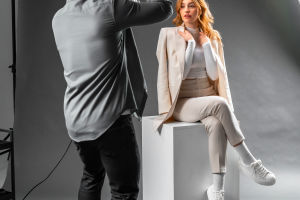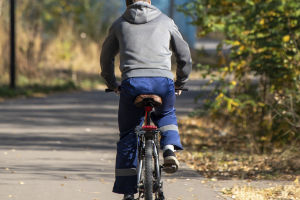Street photography is a wonderful way to capture genuine moments of life, freezing them in time forever. Not only that, but street photography is open to everyone. Whether you're an experienced photographer or just starting, you can make amazing shots without needing expensive gear.
It's all about passion and a curiosity for the world around us. So, if you're looking to improve your street photography skills, check out these useful tips.
1. Get Close
One of the famous quotes by Robert Capa, one of the founders of Magnum Photography, says, “If your photos aren't good enough, you're not close enough.”
When you're shooting street photography, getting close to your subject is key. It allows you to take more intimate photos, making you an active participant rather than just a bystander. Sure, getting close to strangers might feel intimidating at first, but with practice, that fear will fade.
However, don't just get close. Even if you're close, make sure to incorporate the background into the scene. This helps the viewer get the full picture — how the person interacts with their surroundings.
2. Shoot Faces, Not Backs
While some great street photos are taken from behind people, I suggest shooting people's faces whenever possible. Faces are fascinating because no two are exactly alike. Moreover, people's faces often tell a story.
So, avoid shooting people from behind. If you spot someone interesting from behind, try to get in front of them and capture the photo quickly.
3. Tell a Story
Whenever you head out to take street photos, always think about the story you want to tell. Don't just shoot random people or scenes without a narrative. Look for moments where people interact with each other or where their clothing tells us something about their personality.
4. Don't Ask for Permission
When you first start out in street photography, it might seem like a good idea to ask for permission to shoot people, especially strangers. However, street photography is all about capturing candid moments without interference. Relying too much on asking permission can take away the raw and natural feel of the moment.
Why shouldn't you ask for permission? From my experience, when you ask for someone's approval, they often put on a smile or strike an artificial pose. But when you photograph them without their knowledge, you get a genuine look at who they are.
In most places, as long as you're in a public space, taking photos of people is completely legal. But always make sure to check the laws of your country, especially in Europe or other regions with more complex regulations.
5. Use a Wide-Angle Lens
One of the best ways I found to improve my street photography was by using a wide-angle prime lens. When I first started, I used an APS-C camera with a 50mm lens (equivalent to around an 85mm lens). While the photos were decent, they never felt close enough to the action.
Later, I upgraded to a full-frame camera and switched to a 35mm lens, giving me a broader perspective. This allowed me to focus not just on people, but on the background too. With a wide-angle lens, you give viewers a perspective as though they are standing right next to you.
Currently, I shoot with a 24mm lens, which challenges me to get even closer to my subjects and make the moments feel more intimate.
6. Avoid Homeless People or Street Performers
It's easy to take photos of homeless people or street performers. Anyone can do it, but it doesn't offer much photographic value. While there are ethical ways to shoot homeless individuals, it often feels overdone and doesn't bring anything new to the table.
Instead, focus on photographing regular people on the street. This is not only more ethical but also more challenging.
7. Experiment with Different Angles
95% of photos are taken at eye level, and because of that, we've become so used to this angle that most photos shot this way don't offer anything interesting.
Instead, try shooting from different angles. Try getting low, crouching down, or even pointing your camera upwards from the ground. This makes your subjects look larger and gives your street photos an artistic feel. You can also tilt your camera for more dynamic shots.
Try shooting from high points, like a rooftop, to get unique perspectives of people's shadows or interesting street scenes. Always aim for fresh angles and perspectives when you're out on the street.
8. Study Master Photographers
It's difficult to know what makes a "good" street photograph unless you study the masters. Buy books on street photography, learn about composition, framing, and aesthetic theories. This is one of the best ways to train your eye and improve your vision as a street photographer.
Some street photography masters you should study include:
• Henri Cartier-Bresson
• Robert Doisneau
• Andre Kertesz
• Brassai
• Weegee
• Helen Levitt
• Robert Frank
• Garry Winogrand
• Vivian Maier
9. Shoot Every Day
Woody Allen once said, "80% of success is showing up." Apply this idea to street photography. If street photographers don't practice regularly, how can they expect to improve? I know life gets busy, but make time to go out and shoot — even if it's just for 15 minutes a day.
When I worked a 9-to-5 job, I used my lunch breaks to shoot photos. I know other photographers who wake up early before work to capture the streets. If you're a student, try shooting when you're taking a break from studying. If you have kids, take your camera with you to the park.
Consistency is key, so always keep your camera on you and keep shooting.
10. Wait Before Sharing
With the internet and digital photography today, it's easy to upload hundreds of photos instantly. But editing is more important than ever. Street photographer Garry Winogrand famously said, “Photographers wrongly judge their photos based on the feelings they had when taking them.”
Winogrand would deliberately wait a year before processing his photos, so he could judge them based on their form and content, not just his emotions at the time.
So, even if you're excited about a great shot, let it sit for a few days before sharing it online. This will help you carefully select your best photos and only share the ones that truly stand out.
Now that you've learned these tips, it's time to grab your camera and get out on the streets! Keep practicing, stay curious, and keep capturing those amazing moments. Remember, the world is full of stories waiting to be told through your lens. Happy shooting, Lykkers!
5 Street Photography Tips You MUST KNOW
Video: Sean Gallagher - Pro Photographer


